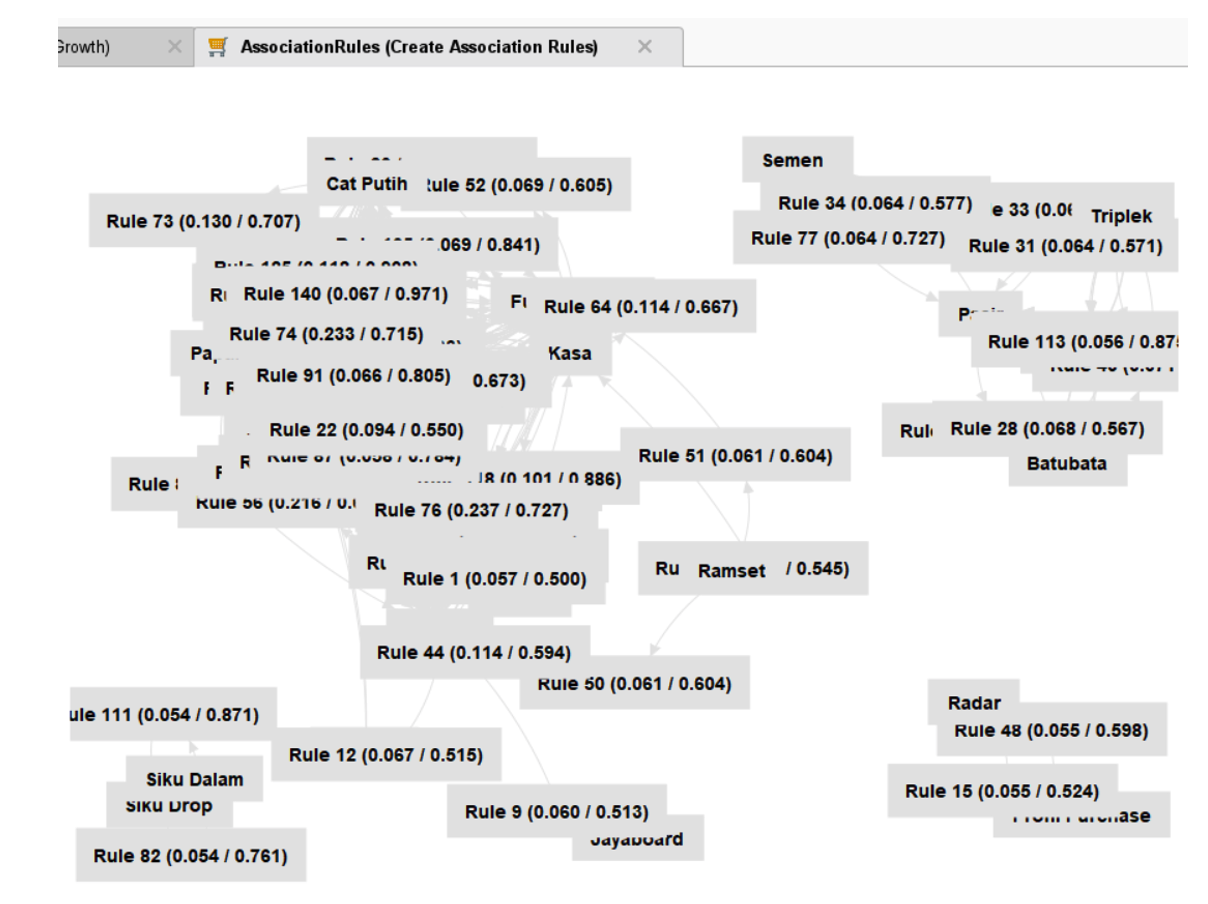Apriori to Analyze Sales Patterns of Building Tools and Materials
DOI:
https://doi.org/10.25299/itjrd.2023.10544Keywords:
Pattern of Sales Building Tools and Materials, Data Mining, Apriori AlgorithmAbstract
The accumulation of transaction data on the sale of building tools and materials, which is increasing day by day, should be used as information that can support sales in stores. Consumer purchasing patterns are the main source of data processing. In this study, it is necessary to have a system to process the transaction data based on trends that appear simultaneously in one transaction. The data used is 1000 sales data from December 2020 to May 2021 by calculating the minimum value of support and minimum confidence as a benchmark in the apriori algorithm process, results obtained are in the form of output which is an association rule that will be used by the store. Input the data in the application after that obtain results item set combination. After that these are obtained by calculating the minimum support. The results obtained are processed again with minimum confidence then the results are being final results of association rules that can be used by stores. If the minimum support is 0.1 (10%) and the minimum confidence is 0.5 (50%), then 122 association rules are obtained, one of which is in the 100th order, "If a customer buys a VSB Board, the customer also buys Jumbo Furing with a support value of 23, 3% and a confidence value of 82.9%”. Association rules as the final result are to evaluate, carry out sales strategies, alternative decisions in stocking goods and determine the placement of goods close together.
Downloads
References
V. N. Budiyasari, P. Studi, T. Informatika, F. Teknik, U. Nusantara, and P. Kediri, “Implementasi Data Mining Pada Penjualan kacamata Dengan Menggunakan Algoritma Apriori,” Indones. J. Comput. Inf. Technol., vol. 2, no. 2, pp. 31–39, 2017.
J. Han and M. Kamber, Data Mining Concept and Technique. San Francisco: Morgan Kauffman, 2006.
S. Saefudin and S. DN, “Penerapan Data Mining Dengan Metode Algoritma Apriori Untuk Menentukan Pola Pembelian Ikan,” JSiI (Jurnal Sist. Informasi), vol. 6, no. 2, p. 36, 2019, doi: 10.30656/jsii.v6i2.1587.
M. Delisle, Effective MySQL Management About the Author, no. 4. .
R. W. Sari, A. Wanto, and A. P. Windarto, “IMPLEMENTASI RAPIDMINER DENGAN METODE K-MEANS ( STUDY KASUS : IMUNISASI CAMPAK PADA BALITA BERDASARKAN PROVINSI ),” vol. 2, pp. 224–230, 2018.
H. Gani, “MENGGUNAKAN ALGORITMA APRIORI DAN ALGORITMA CENTROID LINKAGE HIERARCHICAL METHOD ( CLHM ),” vol. 9, no. April, pp. 62–69, 2017.
M. Syukri Mustafa, M. Rizky Ramadhan, A. P. Thenata, K. Kunci -Algoritma Naive Bayes Classifier, and K. Akademik Mahasiswa, “Implementasi Data Mining untuk Evaluasi Kinerja Akademik Mahasiswa Menggunakan Algoritma Naive Bayes Classifier Implementation of Data Mining for Evaluation of Student Academic Performance Using a NBC Algorithm,” Citec J., vol. 4, no. 2, 2017.
S. Sains, M. Siswa, D. Out, and S. Kasus, “Penerapan Teknik Data Mining dengan Metode Support Vector Machine,” vol. 3, no. 1, 2017.
M. Rafi, “Algoritma K-Means untuk Pengelompokan Topik Skripsi Mahasiswa,” vol. 12, no. 2, pp. 121–129, 2020.
D. P. Mulya, “Analisa Dan Implementasi Association Rule Dengan Algoritma Fp-Growth,” Teknol. dan Sist. Inf. Bisnis, vol. 1, no. 1, pp. 1–11, 2019.
D. S. Kusumo, M. A. Bijaksana, and D. Darmantoro, “Data Mining Dengan Algoritma Apriori Pada Rdbms Oracle,” TEKTRIKA - J. Penelit. dan Pengemb. Telekomun. Kendali, Komputer, Elektr. dan Elektron., vol. 8, no. 1, pp. 1–5, 2016, doi: 10.25124/tektrika.v8i1.215.
J. L. Putra et al., “IMPLEMENTASI ALGORITMA APRIORI TERHADAP DATA PENJUALAN,” vol. 15, no. 1, pp. 85–90, 2019.
L. I. Prahartiwi and W. Dari, “Algoritma Apriori untuk Pencarian Frequent itemset dalam Association Rule Mining,” PIKSEL Penelit. Ilmu Komput. Sist. Embed. Log., vol. 7, no. 2, pp. 143–152, 2019, doi: 10.33558/piksel.v7i2.1817.
A. R. Program Studi Teknik Komputer AMIK Bina Sarana Informatika Jakarta Jl Fatmawati no, P. Labu, and J. Selatan, “Data Mining Dengan Algoritma Apriori untuk Penentuan Aturan Asosiasi Pola Pembelian Pupuk,” vol. XIX, p. 74, 2017.
E. C. Sibarani, M. Iqbal, T. Rahmadi, R. Syahputra, T. Informatika, and U. P. Indonesia, “Implementasi kesesuaian obat pada penyakit menggunakan algoritma apriori,” vol. 3, no. 1, pp. 56–62, 2019.
D. Sophia and L. Y. Banowosari, “Implementasi Metode Aturan Asosiasi Menggunakan Algoritma Apriori Pada Data Transaksi Penjualan Di Waroeng Spesial Sambal,” J. Inform. dan Komput., vol. 22, no. 1, pp. 44–56, 2017.
E. D. Sikumbang, “Penerapan Data Mining Penjualan Sepatu Menggunakan Metode Algoritma Apriori,” J. Tek. Komput. AMIK BSI, vol. Vol 4, No., no. September, pp. 1–4, 2018.
M. Fauzy, K. R. Saleh W, and I. Asror, “Penerapan Metode Association Rule Menggunakan,” J. Ilm. Teknol. Inf. Terap., vol. II, no. 2, pp. 221–227, 2016.
S. K. P. Barakbah, Ali Ridho, M. K. Karlita, Tita, S.Kom., and S. K. Ahsan, Ahmad Syauqi, Logika dan Algoritma, no. tahun 2013. Surabaya: PENS, 2012.
D. Nofriansyah and G. W. Nurchayo, “Algoritma Data Mining dan Pengujiannya,” Andi Offset, vol. 2, pp. 1–140, 2015.

Downloads
Published
How to Cite
Issue
Section
License
This is an open access journal which means that all content is freely available without charge to the user or his/her institution. The copyright in the text of individual articles (including research articles, opinion articles, and abstracts) is the property of their respective authors, subject to a Creative Commons CC-BY-SA licence granted to all others. ITJRD allows the author(s) to hold the copyright without restrictions and allows the author to retain publishing rights without restrictions.















